King Louis IX of France, better known as Saint Louis, went crusading. He didn’t plan to liberate the Holy Land and retake Jerusalem, as crusades were purported to accomplish; oh no! His Majesty had much more ambitious aspirations:
To conquer the entire infidel world, rather than marching on Jerusalem, he led the seventh crusade to Egypt. Don’t worry – his GPS did not malfunction; he simply decided that any war on any Islam countries would qualify as Holy War, especially since the Royal spies had assured the King that Sultan al-Malik al-Salih was on his last breath, and there was no one else to defend the mighty empire, originally founded by legendary Saladin.
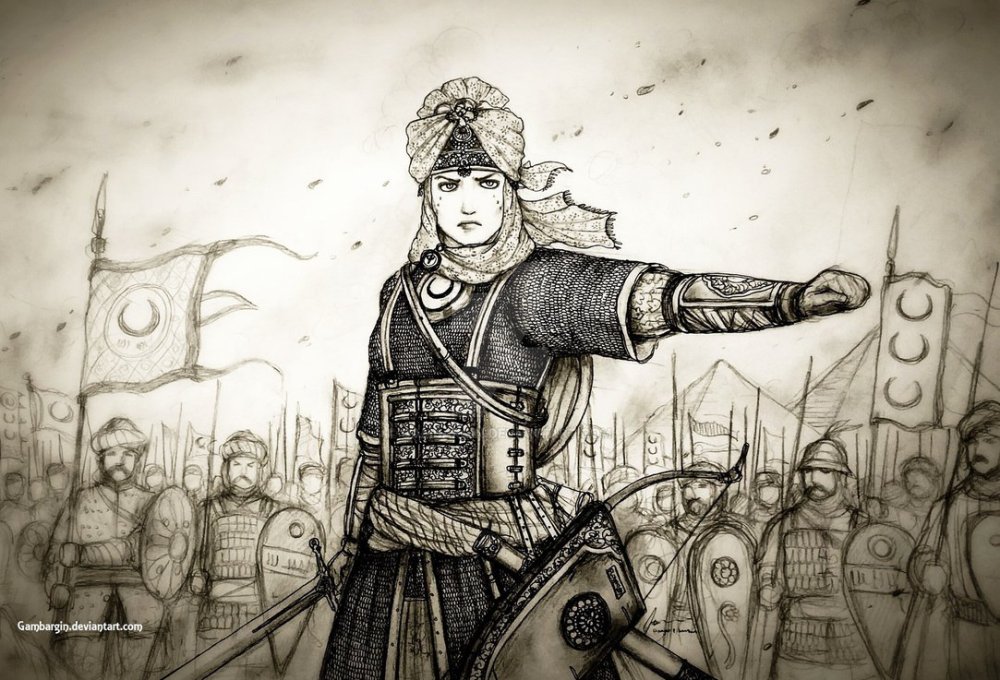
It seems strange that the French King, brought up by a powerful mother, a victorious crusader herself, and married to a no less powerful wife, would underestimate the power of women, but he did, and lost the war to Sultana Shajar al-Durr, the late Sultan’s widow, who consolidated her power on the strength of mamluk spears. The luckless crusader lost his army and ended up in captivity. Make a long story of the hapless seventh crusade short, His Majesty came home six years later and went about the kingly business of making heirs to the throne.
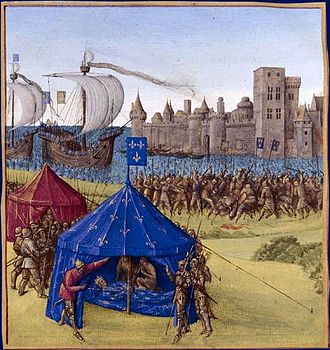
This unfortunate experience has not stopped the zealous future Saint Louis. He waited until his three sons came of age, ordered his younger brother to join the party, and embarked on a new crusade, this time heading for Tunis. This time, the crusade was defeated … by food. The King’s piety moved him to extensive penances and frequent fasting, but above that, in a country full of fruit and vegetables, the crusaders would not touch any local food; they consumed only meat and fish, says French forensic pathologist Dr Philippe Charlier (https://www.dailymail.co.uk). No wonder the army fell victim to scurvy caused by lethal lack of vitamin C. King Louis IX of France, vanquished by food, shared the fate of his troops.
“East is East, and West is West, – remarked Rudyard Kipling, – and never the twine shall meet.” The eighth crusade met with rich Tunisian culture, colorful, spicy, and healthy, and lost. This post is a tribute to one of my students, a lovely and talented Habiba Querghi from Tunisia, who graciously shared with me her recipe for Tunisian Couscous.
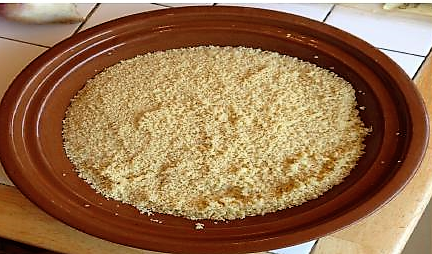
Obviously, the main player in this delectable main course is couscous. You have to cover the grain with water and put it aside until it softens.
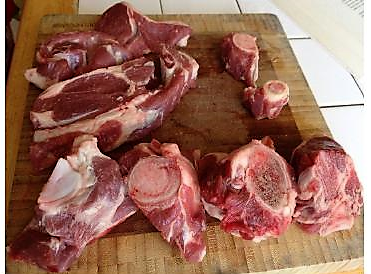
Meanwhile, you get your meat ready, preferably lamb, preferably bone in.
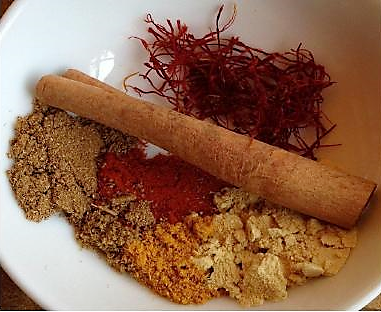
Get your spices ready, or use store-bought ones, if you are not proficient in making your own from scratch.
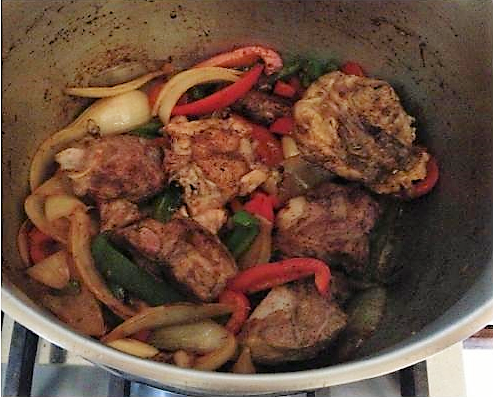
Here comes the crucial moment: this is what the poor crusaders were lacking in their diet – vegetables, especially bell peppers, hot peppers, onions, and potatoes, all rich in vitamin C. Combine meat first with onions, then with the rest of your veggies, including carrots that add vitamin A, another important nutrient.
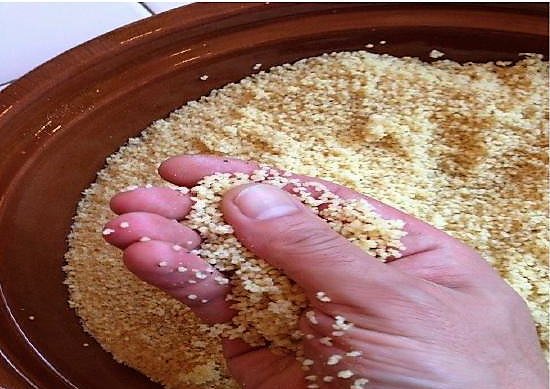
Meanwhile, your couscous should be nice and soft, and you make sure of it by rubbing it with your hand, says Habiba.
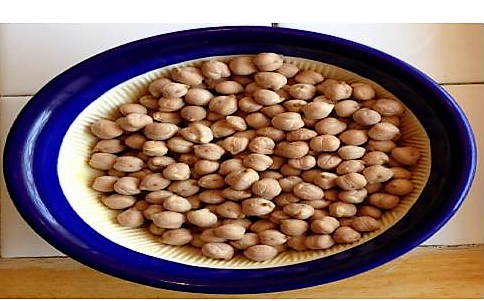
I hope you have soaked and pre-cooked your chickpeas, as Habiba does not use canned beans (neither do I). Beans also nourish your body with plenty of vitamin C.

It’s time to put everything together by using what Habiba calls “couscouserie,” which is essentially a two-level cooking pot, where the bottom level contains meat and vegetables,
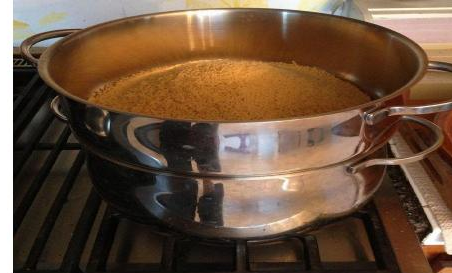
while the top is essentially a colander where the grain cooks in the meaty steam for about 20 minutes. For lack of this special pot, you can use a steam basket.
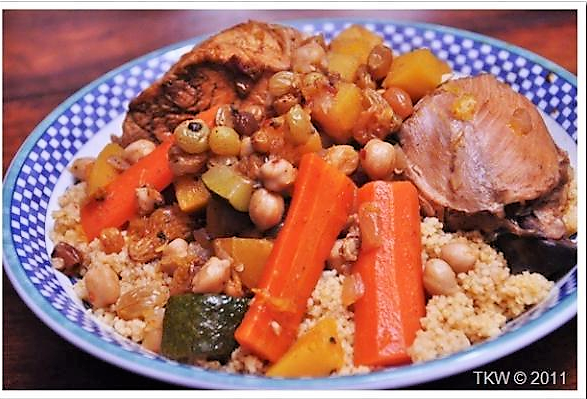
Serve it by covering steamy couscous with juicy vegetable and tender lamb meat that practically falls off the bone. Had Louis IX of France deigned to partake of this fantastic native dish, perhaps his Tunisian adventure might not have ended in a complete fiasco.
INGREDIENTS
- 1 cup of couscous grain, uncooked (makes 2 cups when cooked)
- 2 lbs meat, bone in (preferably lamb)
- 1 cup chickpeas, precooked
- 1 large yellow onion, sliced in semi-circles
- 1 – 2 medium potatoes, peeled and cubed
- 1 – 2 carrots, cut in large pieces
- 2 green bell peppers, cut in wide stripes
- 2 tablespoons olive oil
- Complete Seasoning, Jerk Seasoning, ground black pepper, chili, paprika, salt, tomato paste, Harissa (hot chili pepper paste) to taste
PROCEDURE
- Cover couscous with warm water, put aside until soft, about 20 minutes.
- Saute meat in oil with onion and spices until lightly browned, cover with water, bring to boil, reduce heat to medium, cook for 30 minutes.
- Add vegetables and chickpeas, bring to boil. Rub couscous by hand or mix with spoon, place into top part of pot or steam basket, simmer together for 20 minutes.
- Serve meat and vegetables on the bed of couscous.
Enjoy!
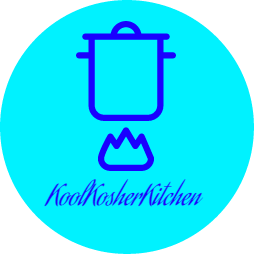
I love the stories you tell in your posts. I studied history in college and still enjoy the subject, but rarely do academic courses cover the subjects you write about. It’s actually rather sad that historians don’t write more about food!
LikeLiked by 4 people
Thank you so much, dear friend. You are so right; I have to research for every post to come up with am appropriate story, and I find lack of historical sources. I guess historians have always been more interested in battles than food!
LikeLike
More fascinating history to introduce your recipe. I’m not generally a fan of couscous, but you make it look appetising
LikeLiked by 3 people
Thank you so much, Derrick. Actually, I have long ago substituted quinoa for couscous in all Mediterranean recipes; you might want to tell Jackie to give it a try.
LikeLiked by 1 person
I will
LikeLiked by 1 person
Thank you, Derrick. Of course, I have nothing to teach The Culinary Queen!
LikeLiked by 1 person
Interesting post Dolly and nice and healthy dish!
LikeLiked by 2 people
Thank you so much, Gary!
LikeLike
What a gorgeous sounding tasty dish….I love meat and vegetables cooked like this so tasty 🙂
LikeLiked by 2 people
Thank you so much, dear Carol! It’s also very good with quinoa instead of couscous, and my daughter-in-law also adds golden raisins.
LikeLiked by 1 person
I’ll bypass on the raisins I am not a fan except in a fruit pudding or cake
LikeLiked by 1 person
Ah, and I think raisins go with lamb like Superman and his cape.
LikeLiked by 1 person
Far too sweet for me…I just don’t like them in savoury dishes…:) x
LikeLiked by 1 person
Got it. Enjoy whatever you find enjoyable, dear friend.
LikeLiked by 1 person
Oh I do, dearest, Dolly and it is just as well we are not alll alike however I was put off as a child and sometimes those memories stay with us and that one has…haha
LikeLiked by 1 person
I know exactly what you mean; I can’t even hear the word “farina” without a shudder – overfed with it as a child.
LikeLike
I must try quinoa I keep saying I will and then forget when I go shopping 🙂
LikeLiked by 1 person
Absolutely – it’s so versatile; you can use it instead of rice or pasta, or in salads, and it’s all protein and almost no carbs.
LikeLiked by 1 person
I enjoyed the history lesson and the lamb couscous sounds delicious. I love lamb and don’t eat it nearly enough. 🙂
The two part cooking style reminds me a bit of Indian biryani …. the meat is marinated and cooked with the spices and then washed raw rice is placed top, water is added, the lid is put on and the whole thing is steamed to finish.
LikeLiked by 2 people
Thank you so much for your comment, dear friend. Yes, I do make briyani, but I still pre-cook rice a little, since I prefer to use brown rice or a combination or brown and wild.
Incidentally, the true Uzbekian plov is made in the opposite sequence: first women cook rice with grated carrots, then men come in, chase women out of the kitchen and add meat and whole garlic bulbs. Meat is supposed to be men’s food and men’s business.
LikeLiked by 1 person
This dish looks and sounds very delicious Dolly 😀
LikeLiked by 2 people
Thank you so much for your kind comment, dear Irene!
LikeLiked by 1 person
The stew sounds amazing. One of my aunts in Israel has Tunisian-Jewish roots, and she makes the couscous itself from scratch, which is amazing!
LikeLiked by 2 people
Thank you so much, dear Ronit. I would think that you, of all people, would know exactly what this stew is.
How does one make couscous from scratch?
LikeLiked by 1 person
It’s quite a lengthy process, of mixing semolina with water and oil, steaming it, then separating the cooked semolina with a special sieve, then steaming it again, and fluffing it, and again… As much as I’m all for preparing things from scratch, this one is not on my list… 🙂
LikeLiked by 2 people
Yes, it looks like too much scratching. 😻
LikeLiked by 2 people
Crusaders were idiots, as far as i am concerned. You get a Rabbi who teaches love and grace, claim to follow him, and then turn around and try to conquer people with war. It’s unholy and wrong.
This food, though, is good and right!
LikeLiked by 4 people
Right you are, dear Mimi! The food is excellent, and Louis was a fool who died because he refused to eat “infidel food.” Thank you for your comment, darling!
LikeLike
Lovely but sad story. Yummy looking coucous!
LikeLiked by 2 people
You can’t rewrite history, Melinda! I am glad you like the recipe, dear purple person, and you can also substitute quinoa for couscous (I do).
LikeLiked by 1 person
I love Couscous! I grew up on that stuff. I was born in Tunisia, Sfax.
LikeLiked by 2 people
Is that right? Wow! Do you make tabbouleh? I have an ongoing argument with my daughter-in-law (in a loving way!): which herbs to use in tabbouleh, mint or parsley. What’s your opinion?
LikeLiked by 1 person
I’ve made tabbouleh with parsley but I love mint so why not both?
LikeLiked by 1 person
My daughter-in-law is Moroccan, and their preference is parsley, while my Tunisian friends insist on mint. I’ve tried to combine, and they clash – no good.
LikeLiked by 1 person
Oh alright , thank you for that. I can see how they would clash and ya I prefer parsley too 🙂
LikeLiked by 1 person
I thank you for your generous feedback, dear Jackie!
LikeLiked by 1 person
Thank you Dolly for once again combining a great recipe with history! Of course you got me a little more curious about Louis IX. Alas, my research revealed some troubling facts about him, in particular how he made your people wear a distinctive sign (a circle) on their clothes, thus recycling an old rule already in existence back in 888 in what is now Tunisia, back then applied to both Christians and Jews in the city of Kairouan under Qadi (Judge) Ahmed Ben Talib. Sad to see that no matter what the time or place, rulers like to stigmatize those who do not belong to the religious or cultural mainstream.
I love couscous for its spiciness. I use my own blend of paprika, cumin, ginger, cardamom and of course quite a bit of my homemade hot pepper sauce. I find that I can adjust the recipe according to the season, using rutabaga in the winter, but never omitting the chick peas (canned version for now, maybe I will some day switch to the real thing!). I used to think that couscous, as much as I loved it, didn’t agree with me… until I realized the culprit was the gluten in the grain! Fortunately, I have been able to buy gluten-free grain (made from rice and corn, or simply buckwheat) in my regular organic food store and so we get to enjoy this delicious, heart-warming dish several times a year! King Louis didn’t know what he was missing, and couldn’t have guessed that centuries later, couscous would become a staple food in French cuisine!
LikeLiked by 3 people
Ah, dear Joelle, in my research into Louis IX, I found so many troubling facts, that I had to spend some time filtering out those I thought might be offensive to all three monotheistic faiths. Oh well, those were the dark ages and darker practices!
I like your blend of spices; mine is very similar, minus hot peppers, but plus sumac. As to chick peas, as well as all the beans, I had to learn to sprout them (as per my husband’s doctor’s orders), which is truly a very simple and not time-consuming procedure. Once they show little cute tails, I throw them into my Instant Pot and press the button. I sprout and cook various beans by large batches, then portion them out and freeze them, to be defrosted per need.
I’ve also substituted quinoa for couscous long time ago, to avoid carbs as much as possible. Do you use quinoa?
LikeLiked by 1 person
Sprouting chickpeas, now that’s an interesting idea! I will have to try it. They should have more vitamins this way! But it won’t be just yet: with temperatures reaching 105°F today and into the weekend (unheard of over here), I am staying away from any cooking at all. Yes, I use quinoa but never have with couscous, as we mostly eat it in cold salads.
Have a nice end of week, Dolly!
LikeLiked by 1 person
I am still in Las Vegas – also 105F, so we are in the same boat, dear friend! The only difference is that I don’t have to cook but we are fed very well by two fantastic kosher restaurants.
LikeLiked by 1 person
Have a nice trip, Dolly, and don’t forget to stay hydrated!
As for us, we will be traveling to cool and beautiful Brittany very shortly, which should mean more bearable temperatures 😎
LikeLiked by 1 person
We just got back, and it was pretty warm there, but it was to be expected. Enjoy cooler temperatures, dear Joelle!
LikeLiked by 1 person
Love harissa; it goes so well with couscous; especially mixed with sauce juices from meats.
LikeLiked by 2 people
My younger son would totally agree with you, Rachel.
LikeLiked by 1 person
A very excellent article, I enjoyed the read so I am going to reblog this one for you.
LikeLiked by 2 people
Thank you so much for reblogging, dear friend!
LikeLike
I’ve only recently (within the last five years or so) learned to eat chicken, and I’m not sure I’m ready to tackle lamb. Ugh. However, that being said, I love both couscous and quinoa – as well as rice and noodles.
I’ll have to give this a try. It sounds as if it makes a boatload. Do you have any idea how many it’s meant to serve? There are only two of us!
LikeLiked by 2 people
First of all, you can make it with chicken or turkey, if you are not used to lamb. This is a portion for 4, and you can easily save leftovers for another day. Good luck dear friend – enjoy!
LikeLike
From Crusaders to couscous! Not that’s a wide range of topics. 🙂
LikeLiked by 2 people
Wherever my funky imagination takes me, dear Anna!
LikeLiked by 1 person
I was intrigued by a previous post of yours on sprouting beans to make them more digestible. I started with white beans and it worked! They are easier on the digestive system. I was surprised at how long they took to sprout. Possibly because I am in a drier climate than you. I rinse them whenever I pass by them rather than once or twice a day. I am now sprouting mayocoba (peruano) beans, and they are taking just as long–over a week. It is so easy to do and so worth it. Also, I can’t tell any difference in taste. Thanks for sharing this process, Dolly.
LikeLiked by 2 people
I am so glad to have been helpful, dear Linda, I even more glad that you are now eating healthier!
LikeLiked by 1 person
Great! Thank you very much for another great recipes and story. Have a nice day! Best wishes, Michael
LikeLiked by 1 person
Thank you so much, Michael. The credit for recipe goes to my lovely student Habiba.
LikeLike
In my humble opinion, North African food/recipes beats French food hands down. I love the mix of seasonings, textures and freshness in North African cuisine, especially Moroccan dishes. Love the back story, Dolly. They deserved their scurvy!
LikeLiked by 2 people
Based on my daughter-in-law’s cooking, I wholeheartedly agree, dear Kerry! Thank you for stopping by and commenting.
LikeLike
You are most welcome!
LikeLiked by 1 person
Great photos, looks yummy 😊
LikeLiked by 1 person
Thank you so much; I am so glad you like it! Photos were provided by my student Habiba, together with the recipe.
LikeLike
I love the stories you tell in your posts.
LikeLike
Thank you for your kind words, darling!
LikeLike